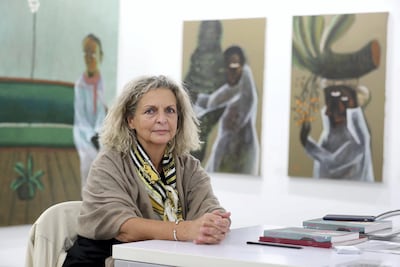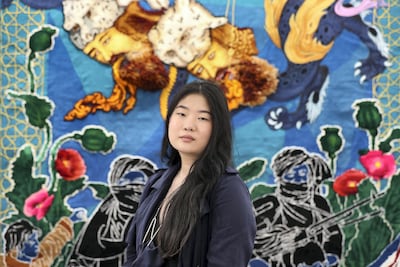Against the odds, Art Dubai kicked off on Monday.
The fair, now in its 14th year, was among the first to be disrupted by the Covid-19 pandemic in 2020. Art Basel Hong Kong cancelled its March event as coronavirus began to spread. Soon after, the team behind the annual Dubai event took its programming to the virtual realm, creating an online catalogue and hosting the annual Global Art Forum via livestream.
It seems things are coming full circle for organisers this year, however, as Art Dubai is now among the first to stage a physical art fair in 2021, although this has come with a few adjustments.
For starters, it has had to move from its usual home of Madinat Jumeirah to Dubai International Financial Centre (DIFC), where booths are housed in purpose-built tents under the Gate Avenue building. The number of participating galleries has also been reduced from the typical 90 galleries to 50. The smaller set-up does have its advantages, as we bypass the often dizzying experience of large fairs.
Another change is that this year’s booths have been divided up into three halls, with no obvious categories, unlike previous years’ curated sections. Stripped of the themes and expansive public programming, Art Dubai 2021 hones in on what it needs to do – sell art.
With the lockdowns and cancelled events of 2020, the art world has taken various measures to try and stay afloat. Many boosted their online marketing, joining art market platforms and revamping their own websites to keep collectors’ interest. Galleries at Art Dubai 2021 see the physical fair as an opportunity to make up for what the virtual world has not quite delivered – making connections with collectors.
Personal connections lead business
Circle Art Gallery from Nairobi, Kenya, for example, is participating in an in-person art fair for the first time since the pandemic started. Its booth features works by Sudanese artist Salah Elmur, whose retrospective was shown at Sharjah Art Museum in 2018 and whose paintings have been recently been acquired by Centre Pompidou, and Egyptian artist Souad Abdel Rasoul.
Danda Jaroljmek, the gallery’s director, says that despite boosting their online profiles and joining virtual fairs, the efforts have “not been hugely successful”.
"Our business is really based on personal connections," she told The National. "While we get enquiries from new networks, it's mostly the people we do know and built relationships with are the ones who come back."
Now, she is waiting to see if the international crowd will show up. “It’s only the beginning of day two, so it’s hard to tell what type of collectors are actually here, whether people have flown in,” she says.
Online sales expected to rise
Erica Kyung, a sales associate at Aicon Gallery, unlike Jaroljmek, expects that its sales will still take place online. She sees the fair as an opportunity for patrons, collectors, dealers and artists to meet and catch up, with those interactions becoming the focus of their attendance.
“While there are people coming and everyone is excited to see each other again, I think where the actual art acquiring comes from will be the online enquiries. Even with the physical component, we are seeing a shift for more serious enquiries online.”
Located in New York, Aicon has brought over works by a mix of established, mid-career and emerging artists such as Rasheed Araeen, Rachid Koraichi, Khadim Ali, Saba Qizilbash and Saad Qureshi.
'Masks are inhibiting'
For the Tropical Futures Institute, a gallery from the Philippines, the first day already brought in regional institutional interest, with one work by Kristoffer Ardena being sold. Gallery director Chris Fussner says the decision to come to Art Dubai was "nerve-racking", with the general cloud of uncertainty hanging over many events in the last year. "It was intense to say the least," he says.
While the hand-wringing over the opening is over, Fussner says the gallery still has to consider how it will manage fees and the artists when sales come in. The fair’s new payment structure, where organisers take a cut of the proceeds instead of the usual stand fee, has made it “a little easier to come in and participate”, says Fussner, though he still has to cross a certain threshold to make the venture worthwhile.
The gallery may be off to a good start, but he says Covid-19 guidelines are making it harder to establish connections. “The masks are inhibiting in terms of micro-expressions and communicating,” he says. The absence of social events this year – parties and private lounges were once staples of any fair – might also hinder chances to network, he adds.
Elodie Cassamajor, a consultant for Tafeta gallery in London, echoes the same sentiment. "With the masks, sometimes it's hard to understand what people are saying or make myself understood, but I think we have to get used to it," she says. Her gallery, which has experienced cancelled events in the past, namely The European Fine Art Fair (Tefaf) Maastricht in the Netherlands, which was shut down early in March 2020 because of a Covid-19 outbreak, is showing the works of Niyi Olagunju and Nkechi Ebubedike, and Babajide Olatunji, whose delicate hyper-realistic drawings are magnetic.
Tafeta – among others – are hoping that Art Dubai 2021 won’t meet the same fate as the Dutch event. There have been hiccups along the way, after all, including a delayed shipment that meant an artwork could not be not shown in time for the first day, something which seems to be a pattern, with many booths still welcoming artworks on the morning of the second day.
Nevertheless, Cassamajor is grateful the event has been able to go ahead. “We feel lucky to participate in a physical fair," she said. "The collectors need to see the works in person and to engage with the artwork in person. It’s not the same [as it was before], but we have tried to adapt and move forward."
Hales' batting career
Tests 11; Runs 573; 100s 0; 50s 5; Avg 27.38; Best 94
ODIs 58; Runs 1,957; 100s 5; 50s 11; Avg 36.24; Best 171
T20s 52; Runs 1,456; 100s 1; 50s 7; Avg 31.65; Best 116 not out
BMW M5 specs
Engine: 4.4-litre twin-turbo V-8 petrol enging with additional electric motor
Power: 727hp
Torque: 1,000Nm
Transmission: 8-speed auto
Fuel consumption: 10.6L/100km
On sale: Now
Price: From Dh650,000
UAE currency: the story behind the money in your pockets
GAC GS8 Specs
Engine: 2.0-litre 4cyl turbo
Power: 248hp at 5,200rpm
Torque: 400Nm at 1,750-4,000rpm
Transmission: 8-speed auto
Fuel consumption: 9.1L/100km
On sale: Now
Price: From Dh149,900
Chef Nobu's advice for eating sushi
“One mistake people always make is adding extra wasabi. There is no need for this, because it should already be there between the rice and the fish.
“When eating nigiri, you must dip the fish – not the rice – in soy sauce, otherwise the rice will collapse. Also, don’t use too much soy sauce or it will make you thirsty. For sushi rolls, dip a little of the rice-covered roll lightly in soy sauce and eat in one bite.
“Chopsticks are acceptable, but really, I recommend using your fingers for sushi. Do use chopsticks for sashimi, though.
“The ginger should be eaten separately as a palette cleanser and used to clear the mouth when switching between different pieces of fish.”
The specs: 2018 Genesis G70
Price, base / as tested: Dh155,000 / Dh205,000
Engine: 3.3-litre, turbocharged V6
Gearbox: Eight-speed automatic
Power: 370hp @ 6,000rpm
Torque: 510Nm @ 1,300rpm
Fuel economy, combined: 10.6L / 100km
A list of the animal rescue organisations in the UAE
Company%20Profile
%3Cp%3E%3Cstrong%3ECompany%20name%3A%3C%2Fstrong%3E%20Hoopla%3Cbr%3E%3Cstrong%3EDate%20started%3A%20%3C%2Fstrong%3EMarch%202023%3Cbr%3E%3Cstrong%3EFounder%3A%3C%2Fstrong%3E%20Jacqueline%20Perrottet%3Cbr%3E%3Cstrong%3EBased%3A%3C%2Fstrong%3E%20Dubai%3Cbr%3E%3Cstrong%3ENumber%20of%20staff%3A%3C%2Fstrong%3E%2010%3Cbr%3E%3Cstrong%3EInvestment%20stage%3A%20%3C%2Fstrong%3EPre-seed%3Cbr%3E%3Cstrong%3EInvestment%20required%3A%3C%2Fstrong%3E%20%24500%2C000%3C%2Fp%3E%0A
Key findings of Jenkins report
- Founder of the Muslim Brotherhood, Hassan al Banna, "accepted the political utility of violence"
- Views of key Muslim Brotherhood ideologue, Sayyid Qutb, have “consistently been understood” as permitting “the use of extreme violence in the pursuit of the perfect Islamic society” and “never been institutionally disowned” by the movement.
- Muslim Brotherhood at all levels has repeatedly defended Hamas attacks against Israel, including the use of suicide bombers and the killing of civilians.
- Laying out the report in the House of Commons, David Cameron told MPs: "The main findings of the review support the conclusion that membership of, association with, or influence by the Muslim Brotherhood should be considered as a possible indicator of extremism."
The biog
Name: Dr Lalia Al Helaly
Education: PhD in Sociology from Cairo
Favourite authors: Elif Shafaq and Nizar Qabbani.
Favourite music: classical Arabic music such as Um Khalthoum and Abdul Wahab,
She loves the beach and advises her clients to go for meditation.
if you go
The flights Fly Dubai, Air Arabia, Emirates, Etihad, and Royal Jordanian all offer direct, three-and-a-half-hour flights from the UAE to the Jordanian capital Amman. Alternatively, from June Fly Dubai will offer a new direct service from Dubai to Aqaba in the south of the country. See the airlines’ respective sites for varying prices or search on reliable price-comparison site Skyscanner.
The trip
Jamie Lafferty was a guest of the Jordan Tourist Board. For more information on adventure tourism in Jordan see Visit Jordan. A number of new and established tour companies offer the chance to go caving, rock-climbing, canyoning, and mountaineering in Jordan. Prices vary depending on how many activities you want to do and how many days you plan to stay in the country. Among the leaders are Terhaal, who offer a two-day canyoning trip from Dh845 per person. If you really want to push your limits, contact the Stronger Team. For a more trek-focused trip, KE Adventure offers an eight-day trip from Dh5,300 per person.
Company profile
Name: Dukkantek
Started: January 2021
Founders: Sanad Yaghi, Ali Al Sayegh and Shadi Joulani
Based: UAE
Number of employees: 140
Sector: B2B Vertical SaaS(software as a service)
Investment: $5.2 million
Funding stage: Seed round
Investors: Global Founders Capital, Colle Capital Partners, Wamda Capital, Plug and Play, Comma Capital, Nowais Capital, Annex Investments and AMK Investment Office
Company profile
Company name: Suraasa
Started: 2018
Founders: Rishabh Khanna, Ankit Khanna and Sahil Makker
Based: India, UAE and the UK
Industry: EdTech
Initial investment: More than $200,000 in seed funding
Bugatti Chiron Super Sport - the specs:
Engine: 8.0-litre quad-turbo W16
Transmission: 7-speed DSG auto
Power: 1,600hp
Torque: 1,600Nm
0-100kph in 2.4seconds
0-200kph in 5.8 seconds
0-300kph in 12.1 seconds
Top speed: 440kph
Price: Dh13,200,000
Bugatti Chiron Pur Sport - the specs:
Engine: 8.0-litre quad-turbo W16
Transmission: 7-speed DSG auto
Power: 1,500hp
Torque: 1,600Nm
0-100kph in 2.3 seconds
0-200kph in 5.5 seconds
0-300kph in 11.8 seconds
Top speed: 350kph
Price: Dh13,600,000
Global state-owned investor ranking by size
|
1.
|
United States
|
|
2.
|
China
|
|
3.
|
UAE
|
|
4.
|
Japan
|
|
5
|
Norway
|
|
6.
|
Canada
|
|
7.
|
Singapore
|
|
8.
|
Australia
|
|
9.
|
Saudi Arabia
|
|
10.
|
South Korea
|
COMPANY%20PROFILE%20
%3Cp%3E%3Cstrong%3EName%3A%3C%2Fstrong%3E%20Haltia.ai%0D%3Cbr%3E%3Cstrong%3EStarted%3A%3C%2Fstrong%3E%202023%0D%3Cbr%3E%3Cstrong%3ECo-founders%3A%3C%2Fstrong%3E%20Arto%20Bendiken%20and%20Talal%20Thabet%0D%3Cbr%3E%3Cstrong%3EBased%3A%3C%2Fstrong%3E%20Dubai%2C%20UAE%0D%3Cbr%3E%3Cstrong%3EIndustry%3A%3C%2Fstrong%3E%20AI%0D%3Cbr%3E%3Cstrong%3ENumber%20of%20employees%3A%3C%2Fstrong%3E%2041%0D%3Cbr%3E%3Cstrong%3EFunding%3A%3C%2Fstrong%3E%20About%20%241.7%20million%0D%3Cbr%3E%3Cstrong%3EInvestors%3A%3C%2Fstrong%3E%20Self%2C%20family%20and%20friends%26nbsp%3B%3C%2Fp%3E%0A
Results:
6.30pm: Maiden Dh 165,000 1,400m.
Winner: Walking Thunder, Connor Beasley (jockey), Ahmad bin Harmash (trainer).
7.05pm: Handicap (rated 72-87) Dh 165,000 1,600m.
Winner: Syncopation, George Buckell, Doug Watson.
7.40pm: Maiden Dh 165,000 1,400m.
Winner: Big Brown Bear, Pat Dobbs, Doug Watson.
8.15pm: Handicap (75-95) Dh 190,000 1,200m.
Winner: Stunned, Pat Dobbs, Doug Watson.
8.50pm: Handicap (85-105) Dh 210,000 2,000m.
Winner: New Trails, Connor Beasley, Ahmad bin Harmash.
9.25pm: Handicap (75-95) Dh 190,000 1,600m.
Winner: Pillar Of Society, Pat Dobbs, Doug Watson.
Lexus LX700h specs
Engine: 3.4-litre twin-turbo V6 plus supplementary electric motor
Power: 464hp at 5,200rpm
Torque: 790Nm from 2,000-3,600rpm
Transmission: 10-speed auto
Fuel consumption: 11.7L/100km
On sale: Now
Price: From Dh590,000




























